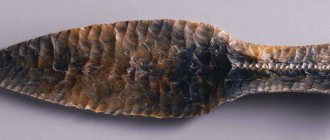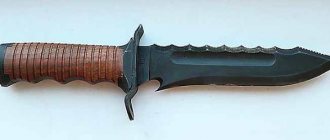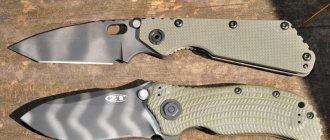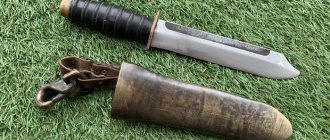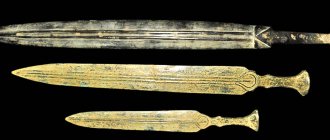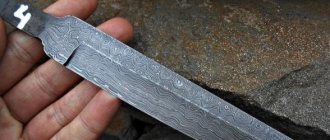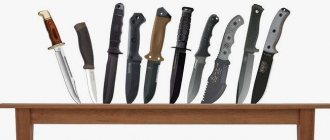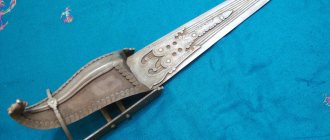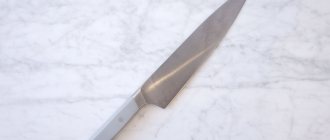The “knife world” is very wide and diverse. Each blade has its own origin story, and, as a rule, it is quite interesting and multifaceted. The origin of many knives is connected with certain events taking place, both in small corners of the planet and on a global scale. The First World War greatly influenced edged weapons. New models appeared, old ones were modernized. One of the discoveries of those times was the trench knife.
Prerequisites for creating German trench knives
The beginning of the war itself was swift and merciless. In one way or another, 38 countries were involved in it. But over time, it moved into a stage of a positional, “wait-and-see” nature.
There were fewer and fewer major battles, but all of Europe was dug up and down with trenches. In which there were opponents from different sides.
Soldiers in a trench during the First Pestilence War.
Small skirmishes and raids against each other periodically occurred between them. The bayonet was considered the main melee weapon at that time, and it is very effective in other circumstances of a military attack, but in a trench in close combat it turned out to be useless. Hand-to-hand combat developed into banal fights, with the use of fists and even teeth.
The soldiers made weapons for attack from everything that came to hand. Batons with reinforced impact elements. From nails and metal rods that soldiers could get, they began to make piercing and cutting weapons. Such artisanal production led to the concept of a trench knife.
You can’t turn around much in narrow trenches, so such a small blade with good penetrating capabilities has become very valuable in such a battle. The main characteristic of a trench knife was its small size.
Previously, the armies of all countries did not use such lightning-fast attacks behind enemy lines in their strategy. And they were practically not prepared for such a turn of events.
The idea of creation
The officers conveyed information to headquarters about the need to develop and adopt a new type of melee weapon for close combat. A competition was held and the winner was. The blade version proposed to the French War Ministry by the commandant of Paris, Georges Dubois, in December 1915 was taken as the basis. A narrow triangular blade with a wooden handle covered with a steel strip with pyramidal protrusions that turned it into brass knuckles (from the French castete - “breaking the head”). The idea seemed interesting, but in France the trench knife project had already been agreed upon and sent into production, and this idea was picked up by the ubiquitous Americans.
DIY modifications of trench knives
Poster of those times.
Perhaps it will seem incomprehensible to someone - the era of edged weapons is over and firearms have long been in the “arena”. Arm each soldier with a revolver and the trick is in the bag. But, unfortunately, the production of short-barreled firearms was not so developed at that time. Therefore, the first trench products looked rather strange:
- a sapper's shovel, sharpened on three sides, was a universal weapon. It could be used to deliver stabbing blows to the neck, or backhand cutting blows. The blow was heavy and caused serious injuries to the enemy;
- soldiers had to go back to the Middle Ages using a mace or morning star. Trench clubs were also used; they even had spikes. They invented knives with brass knuckles, which were convenient in a fight;
- nails and rods were sharpened for short blades. And the bayonets received a second life, thanks to various alterations. There were specimens of different lengths and widths, as well as different sharpenings.
Many varieties of “homemade products”.
All these, so to speak, trench devices were made right on the knee, by the soldiers themselves. With their help, operations to clear trenches were carried out.
It is quite difficult to recognize these devices based on nationality.
For example, it is known for certain that the French used compact knives of their own production. The so-called stilettos had fairly good piercing ability. The armies of all countries declared to their superiors about the need for small combat knives.
Historical reference
The founder of the modern bayonet is considered to be the spear, known since ancient times, which was improved by the French. To protect infantrymen in the city of Bayonne, a special dagger known as a “bayonet” or “baguinet” was invented.
The French were the first to attempt to cross firearms with bladed weapons.
Bayonet knife.
At the beginning of the 18th century, the first needle bayonets appeared in the arsenal of European armies.
They supplanted baguettes, thanks to their more advanced design: the arrangement of a round bushing, with the help of which it was quickly attached to the barrel of a weapon.
The detachable bayonet was a needle-shaped T-shaped blade, equipped with three or eight blades, which ensured its considerable strength and optimal lightness.
The first factory models of trench knives
The French were again the first to listen to their soldiers. And already in October 1915, blades made in the 1870 model began to appear in the trenches. Germany also responded quickly and launched the production of German trench knives.
French knife model 1870 - Avenger.
The blades themselves might differ slightly in shape, but the same characteristics were: a blade of about 12.5 cm, a width of 2 cm, a wooden handle and stiffening ribs.
This is how a trench knife should look in very cramped conditions; you can’t wave a sword around. What was needed was a compact, good cutting and piercing wedge.
Bottom line
In modern armed forces, bayonets remain a sidearm in many military units. Their designs continue to improve, leaving them with defense and attack functions.
Previous
Kitchen knivesCheese slicer: 10 well-known varieties for convenient slicing
Next
KnivesSafety precautions with a knife: we use it correctly in everyday life and in battle
The appearance of the M 1918 trench knife
The Americans, who had been watching the First World War for a long time, were preparing to enter it. Taking into account the mistakes of the Allies, knowing that a blade for a specific purpose would be needed on the battlefield, they released their M1917 brass knuckle dagger. The narrow tetrahedral blade with a dagger sharpening had a length of 14.4 cm.
There were also options with a round cross-section, for delivering only piercing blows, but they did not take root.
The handle on both types was made of wood with a brass strip that reached the crosspiece and performed its functions. The handle had protrusions in the form of spikes; this was the so-called brass knuckles.
Literally a few months later, a new blade came out, the handle received a cast form with four rings for the fingers, it was a full-fledged brass knuckles. The blade remained a dagger type - they called it M 1918. The blade's shank was shaped like a spike, which could be used to deliver a fatal blow to the head.
American dagger-knuckles M1918.
This knife was immediately adopted by the US troops, and it became widespread.
Quite a few blades were sent to the Allies at the front. And the Americans themselves kept it in service with their troops for quite a long time.
Manufacturers M 1918
Of course, in the USA itself, several such blades were produced, “HenryDissonSons” and “Landers, FraryClark”.
Production was also established in France. produced them for quite a long time, even after the end of the war. The only difference was the large handle, but they were branded on the blade only with American designations.
Official name
Despite the fact that this blade was a stiletto with the function of brass knuckles, it received its official name as a knife: “Trench Knife M1917”. The first model had six pyramidal spikes that were stamped around the perimeter of the guard. The nut on the handle also had a pyramidal shape.
This design of the guard had some technological difficulties in manufacturing, so in the same 1917 a second modification of the knife appeared, which was a complete copy of the first, except that the spikes on the guard were stamped out of the sheet directly with the arc unfolded and then simply bent outward, which greatly simplified production knife
Further use of this trench knife showed its low effectiveness, both during close combat and in everyday soldier life. The blade often broke, there were problems with quickly removing the stiletto from the body, brass knuckles were ineffective, there was always a need to have an ordinary knife blade in use, etc. Due to the totality of all these circumstances, already in 1918 the American government sent an application and the French developed a new, significantly improved version of the trench knife, called “Trench Knife M 1918 Mark I”.
text source: https://militariaclub.ru/
The photograph contains an image of an object belonging to the collection (collection) of the State Museum-Reserve Tsarskoye Selo. The Tsarskoye Selo State Museum has the right to authorize or prohibit its use on the basis of Article 36 of the Federal Law of May 26, 1996 No. 54-FZ “On the Museum Fund of the Russian Federation and Museums in the Russian Federation.” For questions regarding obtaining permission to use an image of this item, you can contact
The exhibit is located in
State Museum-Reserve Tsarskoe Selo in the Sovereign Military Chamber, the first museum in modern Russia dedicated to the First World War. GMZ "Tsarskoe Selo" 196601 St. Petersburg, Pushkin, st. Sadovaya, building 7 Fax [email protected]
German trench knives
These blades are also worth highlighting separately; in the orders of 1915, for the production of trench knives, several names are found. "Grabendolch" translated means - trench dagger or "Nahkampfdolch", which meant - a combat knife for fighting at a short distance. And in addition it was prescribed that each infantry company should be equipped with one of the types of daggers in the amount of 6 pieces.
An infantry knife is a necessary weapon for an infantryman. It is clear that this is a rather small quantity; the next order was to produce trench blades. The 9291 model has gained wide popularity among sappers. Even the Prussian trench knife cannot compare with it.
German blade from - 9291.
The Bavarian units accepted the product with the number “929”; it was more reliable due to the fact that the blade and guard were a single whole. Its cost was slightly higher than other options, but the price was compensated by the longevity of the weapon. It can truly be called the most important trench knife of the Wehrmacht.
Bavarian blade - 929.
In 1916, the number of items per company was increased to 12 units, and in 1917 the figure was already increased to 40 units. The knives were not unusual: the blade was 13 cm, the cross was straight, and the handle was attached from two halves with rivets. For those times, this was enough, especially considering its purpose.
There are also Prussian blades with an S-shaped cross, the blade is about 14.5 cm, sharpened on one side or double-edged. According to some reports, during the First World War, Germany produced about 27 varieties of trench blades.
But many documents have not been preserved, but during excavations, some unknown specimens are found. In this case, self-made blades have not yet been taken into account, so an exact figure will never be found.
German tactical knives
After short-bladed edged weapons showed their effectiveness during the First World War, they became an invariable attribute of the ammunition of German soldiers. Knives of the Second World War in Germany practically retained their shape, but their sheaths were modified several times.
The most interesting model of German production from the Second World War is the knife. It was a real universal weapon and an assistant in everyday matters. The use of bakelite as a material for the handle made the handle durable and moisture resistant. Although it was still worth protecting the knife from dampness, because the blade could rust.
In 1942, German industry mastered the production of a new infantry blade, which was no longer forged, but stamped. This significantly simplified production, although the quality of the product decreased. In addition, around the same time, the famous Luftwaffe combat knife appeared, which also practically did not differ in shape from the knives of the First World War.
Modern models of trench knives
Today it is quite difficult to imagine a blade specifically for fighting in a trench. It is more likely to be some kind of multifunctional infantry combat knife. We can safely say that any army version will cope with this task.
A modern version of a trench knife.
Let's not forget that many manufacturers try to draw experience from the past when making modern products. And taking into account the fact that short-barreled firearms are available and production is uninterrupted, chemical weaponry often relegates itself to the background.
In the USA and Germany, they still produce the American M3 trench knife from back in 1943; its thick spine and large sharpening angle prevent it from being used in field conditions. And everyday work with him turns into hard work. For what reason they do them is unknown, maybe as a tribute to the past.
Drawing
Drawing of the US M1918 trench knife.
Drawing of a German Wehrmacht trench knife, model 1942.
Previous National knivesSwedish knife - centuries-old traditions in modern blades
Next
Combat knivesCombat knife "Cartan" - a legend of perestroika
Combat army knives
home / more / history of weapons
The term "combat knife" contains a certain element of slyness. The generally accepted name for such blades is military utility knives .
Hand-to-hand combat (reconstruction)
In the first half of the twentieth century, the use of knives in armies to destroy the enemy took place mainly in trenches and buildings, during direct contact, complicated by the limited ammunition of small arms and the duration of their reloading.
The second half of the 20th century, on the contrary, established the military army knife as an element of equipment - a universal tool.
Standard UTON assault knife of the Czechoslovakian special forces (model 1975)
In third world countries, edged weapons were preserved somewhat longer due to low combat effectiveness and a shortage of available firearms and ammunition.
It should be noted that usually these were not “combat knives”, but converted agricultural tools such as machetes or bolos, or hopelessly outdated bladed weapons - broadswords, sabers, swords.
Trench massacres became much rarer in World War II due to the advent of automatic weapons and the increasing power and effectiveness of artillery and bomb attacks.
If in the First World War the trench knife can still be called a fairly widespread bladed weapon, then in the Second World War the combat army knife was mainly used by special and reconnaissance units.
Combat knife of assault groups of the Royal Italian Navy (World War II)
The only country that mass-produced service knives for the army during World War II and after it was the United States, and there are several reasons for this.
history of weapons US Army knivesarticle
While most of the European knife productions that survived the war were reoriented to the production of entrenching and other hand tools, American production continued to produce specialized products, including those ordered by the military.
Knife KABAR (naval version) mod. 1942 USA
It is worth mentioning the legislation, which in the first third of the 20th century became very strict regarding the circulation of awkward knives.
After the adoption of amendments to Art. in 1935. 182 of the Criminal Code of the RSFSR, the production of “daggers, Finnish knives and similar bladed weapons” has practically ceased.
Legislative restrictions on the carrying of knives in Foggy Albion have virtually eliminated the production of hunting knives and daggers. As a result, British commandos at the initial stage of World War II had to buy butcher knives, which they independently modified to work against the enemy.
A similar situation was noted in the Land of the Rising Sun, where during World War II, Japanese special forces soldiers used Yanagi-ba chef knives as “combat” chef knives for preparing fish dishes with blades of 190 - 350 mm.
Last on the list, but not least, is the difference between theaters of war. The deserts of North Africa and Europe bore little resemblance to the impenetrable jungles of the islands of the Malaysian archipelago and southeast Asia, which made a knife or machete a mandatory part of the equipment of soldiers and marines. It was this feature that led to the active development of the military knife in the US Army and Navy in the middle of the 20th century.
Standard army knife-machete. USA. Used during the fighting in Southeast Asia
The evolution of the army knife in the national armies of the 20th century can be divided into two main directions: borrowing from the outside and the development of one’s own national forms.
Borrowing a knife type is most common among countries that lack their own knife tradition, are under significant influence from military coalition partners, or are forced to urgently adapt to new conditions of warfare.
A version of the USSR universal army knife of the 2nd World War, the so-called. Canadian type knife
The development of their own national designs is inherent in relatively homogeneous national armies, as well as individual national formations operating as part of larger multinational armies. An example of the first is the Finnish army knives, which evolved from the national forms of puukko, and the second is the knives of the Gurkha mercenaries.
Finnish Puukko knife.
Standard knife of the British Army Gorkhi units.
In their pure form, these trends are observed quite rarely. If we talk about Germany, the first half of the 20th century is characterized by its own development of military models based on national hunting knives, while the second half is mainly borrowed from the US and USSR armies.
Standard infantry knife of the Wehrmacht, model 1942. Germany. Infanteriemesser 42.
Looking at the army knives of the USSR, you see the opposite picture: if until the end of World War II the designs were predominantly Northern European and American, then the second half of the 20th century is characterized by its own, very original developments.
history of weaponsTrench knives of Germanyarticle
After the initial period of the First World War, it turned out that a rifle with an attached bayonet was practically useless in a trench, as well as long bayonets removed, which required a certain amount of space for use.
As a result, homemade knives, sharpeners, clubs and brass knuckles became widespread.
Any trench knife. Germany. 1st World War.
The most famous example is the "French Nail" - a knife that had an oval loop of a rod as a handle, used for tensioning barbed wire barriers. The military forges of cavalry units were a great help for their production.
"French Nail"
The “French nail” was still quite a “cultural” product in terms of the accuracy of its manufacture: the vast majority of such homemade products looked similar to prison “nails”, differing only in their larger sizes.
By the beginning of 1915, many obsolete bayonets and cutlasses were, after alteration, used for their intended purpose, but some were transferred to the troops as is, for use as combat knives.
By 1916, it became possible to use some of the incomplete and captured blade bayonets as blanks. Typically, they were shortened and sharpened, sometimes additionally removing fastening elements on the weapon in order to reduce weight.
Swiss bayonet knife for a Schmidt–Rubin rifle (factory conversion)
Since 1916, the Italian army has been armed with shortened modifications of the blade and needle bayonets for the Vetterli-Vitali rifle mod. 1870
Thus, the Belgian trench knife was made from an M 1916 bayonet for a Mauser rifle.
The Czechoslovak units that fought in Italy were armed with a combat knife, the so-called “Pungale,” a modification of the Vetterli rifle bayonet.
The Dutch widely used a modification of the bayonet-dagger for the Mannlicher cavalry carbine as combat daggers.
Since 1916, the Italian army has been armed with shortened modifications of the blade and needle bayonets for the Vetterli-Vitali rifle mod. 1870
Trench knife model 1916. Italy. Conversion of a bladed bayonet for the Vetterli–Vitali rifle mod. 1870
Trench stiletto model 1925. Italy. Conversion of a needle bayonet for a short rifle Vetterli–Vitali mod. 1870
During World War II, converted knives became an attribute of reconnaissance and sabotage units. Especially in countries that do not have a developed knife industry. Therefore, conversions of German bayonets mod. 1884/98 as well as our own, for automatic rifles.
history of weaponsKnives of security forces and the army of the USSRarticle
The shortage of bladed products contributed to the judicious use of even faulty specimens: for an army knife. 1940, not only the rather flimsy wooden sheath was often replaced, but also the wooden handle.
A variant of the 1940 model army knife. THE USSR.
Replacing leather sheaths with homemade duralumin ones from downed aircraft became widespread on the northern front, among the Finnish troops: their lightness, plasticity and ease of decoration earned them great popularity in the Suomi army.
Traditional handmade Finnish army knife. Aviation grade aluminum scabbard.
The alterations affected not only blade bayonets, but also needle bayonets. The shank of such a homemade product was ground and attached to a wooden core through a metal plate that acted as a cross. The French were already distinguished here, having thus disposed of their own needle bayonets for Lebel and Gra rifles during the First World War.
Standard trench stiletto. France. From a blade from a Lebel rifle bayonet. 1st World War.
Trench conversion stiletto. France. 1st World War.
More technologically complex samples had a protective arm for the hand. The most complex homemade products were already quite reminiscent of a brass knuckle knife: the handle was equipped not only with a bow with welded spikes, but also with a massive “skull breaker” in the form of a separate spike welded to the back of this improvised hilt.
Army stiletto brass knuckles USA 1-2 World War (without skullbreaker)
The stiletto blade was intended to pierce thick winter clothing, the hilt was intended to crush jaws, noses and cheekbones, and with the “skull cracker” everything is clear.
history of weaponsCombat knucklesarticle
The German quartermasters turned out to be more perspicacious than their colleagues from the Entente. If a soldier needs a trench knife, let him take an ordinary hunting knife and use it as the commanders order.
A typical German dagger, used both in hunting and in war.
Hunting models immediately went into service with the troops. At the same time, the “bayonet” design was widely used - not so much because of its lethality, but because of its extreme manufacturability and low cost.
The Allied troops that entered the fighting of World War II also noted an acute shortage of army knives.
Standard dagger-knuckles (with a skullbreaker) model 1918. USA. US Mark 1 Trench Knife.
The reserves of knuckle knives available in the United States since the First World War quickly ran out. Army suppliers began urgently purchasing universal and hunting models from manufacturers, to which changes began to be made to increase strength and reduce cost.
In the initial period of active hostilities of World War II, a certain “assortment” of hunting blades was observed in the US Army and Navy, which lasted almost until the end of 1944. Thus, several million of the popular Cattaraugus 225Q and Pal models were delivered to the troops.
Standard combat knife model M3. USA. 1943 Pal
It is documented that in the first months of World War II, American Marines sent to the island of Guadalcanal were instructed to purchase their own knives. A significant part was made up of awkward tourist-oriented models produced for boy scouts.
history of weapons Marine Corps knives article
In fascist Germany, the teenage “Jungvolk” and the youthful “Hitler Youth” became an analogue of the scout movement, whose members received a completely practical field knife, the Fahrtenmesser. The blade had a knife profile and generally established itself as a reliable and quite practical tool, widely copied as a tourist tool after the fall of Nazi Germany.
Scout knife. Sweden.
Models for American Scouts were produced in both Finland and Sweden. The reason was the sales crisis that local knife makers faced in the 1920s. The classic Finnish puukko turned out to be not in great demand either in Europe or in the USA, which prompted the Finns to develop new models to conquer markets. The scout knife, or “partiopuukko”, was designed to become just such a knife.
The “modernized” puukko received a blade with a slight bevel of the spine, a developed limiter, a sheath of the shortened “fishtail” type with a wide blade for wearing on a belt and an additional strap for fixing the handle.
Uniform Finnish army knife model 1919. Finland.
To match this theme, special fittings with a Bourbon lily were ordered, which was also embossed on the scabbard along with the inscription “Be prepared.” Even characteristic knives with wide fullers in the American style were put into production. Ebonite, nickel silver and aluminum alloys were used in the finishing.
catalogCatalog of edged weaponsBayonets, knives, daggers (photo, technical characteristics)
“Partiopuukko” was also chosen by the Finnish military. It is possible that these particular models ended up as trophies in the Winter War of 1939-1940. in the Red Army, prompted the command to develop a similar model - a combat army knife mod. 1940.
Army knife model 1940. THE USSR.
Another direction in the development of the theme of army knives in the Suomi army was the knives of Finnish socio-political organizations. The “Schutzkor Association”, the women’s organization “Lotta Svärd”, the Papuan Movement (Lapuan Hike), the “Academic Karelian Society” (AKS) were fueled by the nationalists of Osterbothnia, and they used decorated puukko from Kauhava, a kind of “Finnish Solingen”, as a ceremonial knife. , became a symbol of Finnish militant nationalism in the first half of the 20th century.
permitsRegistration of weapons (obtaining permits)
saleHow to sell your weapon
storageWho and how often can check the storage conditions of weapons
morePurchase of cartridges, gunpowder, bullets, etc.
licensesPurchase of edged weapons
